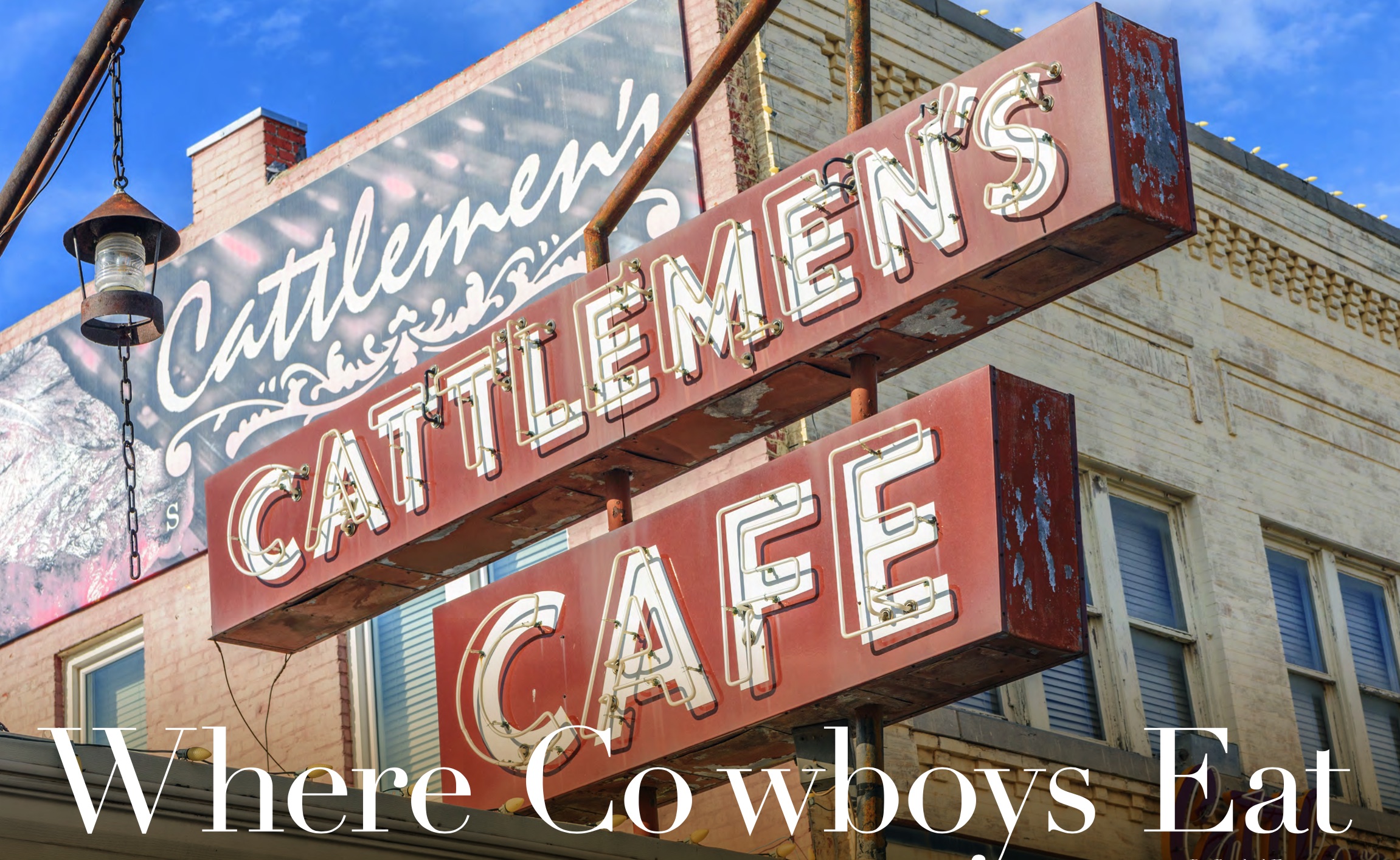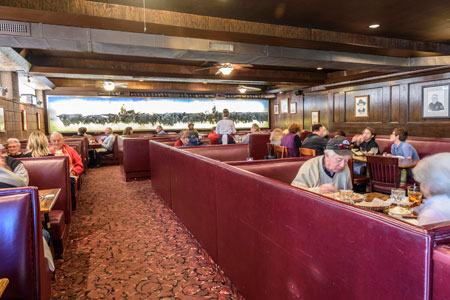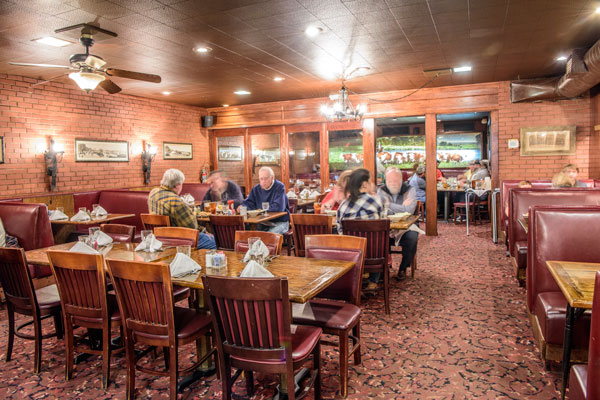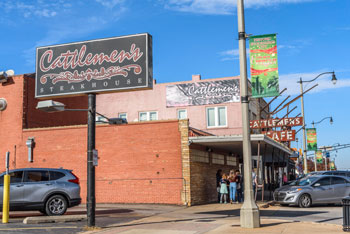Route Magazine Where Cowboys Eat
Where Cowboys Eat Featured In ROUTE Magazine
 Cattlemen's Featured In ROUTE Magazine!
Cattlemen's Featured In ROUTE Magazine!
By Rachel Fernandez
Photographs by Efren Lopez/Route66Images
You might not believe Joy’s full name the first time she tells it to you. When you initially ask her, she’ll say something like, “If I told you my name, you’d just die laughing.” You’ll probably think she’s making it up, but honestly, her full name is Joy A. Weed.
Weed is 71 years young with short silver hair and long, shiny, dark-purple nails that make a satisfying ‘click click click’ every time she types on her phone. She’s chatty and honest and exactly the kind of customer you can expect to meet at Cattlemen’s Steakhouse in Oklahoma City.
“My family’s been eating there since 1961, and my husband’s family has been eating there for 30 years before that,” she said. “Every Sunday we go for breakfast. Any other time, we go for a steak or a chicken-fry.”
If you ask for a suggestion from the menu, she might urge you to try the lamb fries (fried lamb testicles) and “don’t make a face until you try them!” They’re a Cattlemen’s delicacy and one of their most popular appetizers.
Other than swearing by the great quality of the steak, she might also rave about the salad and the creamy house dressing and wonder about which spice they use because her and her family “have been trying to figure out for 50 years what spice he uses in that.” The current owner later confirmed that they sprinkle a little bit of paprika over the top.
Even if you’re just stopping at Cattlemen’s on a Route 66 journey or during a visit to the Oklahoma National Stockyards, Weed will reassure you that “if you’re new in town, that’s alright, they still treat you like you’re home. The food is good and the service is excellent.”

Cattlemen’s Steakhouse is an Oklahoma staple. The restaurant first opened west of downtown Oklahoma City in 1910, the same year that the stockyards started operating as a public livestock market. The stockyards, established to serve as the country’s primary source for meat processing and packing, had the highest concentration of labor at the time, with two meat packing plants operating along with the stockyards and employing over 2,400 people. The area became a hub for cattlemen, farmers, ranchers, and cowboys. And so it was against this backdrop that the beginnings of an industry that would later place Oklahoma City stockyards as the world’s largest market for livestock handling, that a restaurant made its debut as Cattlemen’s Cafe, a place where both locals and stockyard visitors could stop in for a good meal or a cup of coffee. Part of its draw was that it stayed open late and even had a history of serving ‘liquid delights’ during the prohibition era.
To put the age of Cattlemen’s into perspective, the restaurant is almost two decades older than the invention of sliced bread which was first commercially sold in 1928. The restaurant has been around for two world wars, 19 presidents and two sightings of Halley’s Comet. Cattlemen’s is a treasure chest of stories. Perhaps a bit unassuming from the outside, but its walls hold memories as precious as gold and gems. From the restaurant’s ownership changing on a gamble, to U.S. presidents going in for a bite, to simply generations of people who’ve been going there since they were kids, Cattlemen’s has a history and a story that has turned the steakhouse into a legacy.
A Hard Six
By the 1930s, Stockyard City was a bustling town within a town. The stockyards were a tough place, run by tough people. Think old western film. Cowboys on their horses. Spurred boots kicking up dusty dirt roads. Farmers and ranchers coming in to pick up their weekly supplies. Rowdy bars. Seedy hotels. Bootleggers selling whisky and spirits in secret, and gamblers betting big bucks in basements and back rooms. The air foul with the stench from the meat packing plant. And Cattlemen’s Cafe was there, open around the clock, ready to sate the hearty appetites of Stockyard City patrons. Day or night.
The ownership of Cattlemen’s Cafe between 1910 and 1925 is not very clear. However, it appears that H.V. ‘Homer” Paul took ownership of the already popular establishment in 1926. There are tales of Paul and Hank Frey - a known gambler and bootlegger - betting the restaurant back and forth while bootlegging. What is known for certain is that in 1945, Cattlemen’s Cafe was in the hands of Hank Frey.

The chilly Christmas eve of December 1945 found Frey playing a game of craps with a local rancher named Gene Wade Jr.. Wade Jr. most likely got involved in the game because of his rather dubious father, Percy Wade Sr., who was notorious for running underground gambling circles and peddling illegal liquor, and had a sizeable arrest record to show for it. Historical accounts suggest that Wade Sr. had been involved in underground gambling as early as 1945 and had a particular liking for running high-stakes dice games. And so, the story goes: On one fateful night, Frey was on a losing streak at one of Wade Sr.’s popular dice games held at the Biltmore Hotel in downtown Oklahoma City. The 33-story Biltmore Hotel, built in 1932, was at one time among Oklahoma City’s tallest buildings, and was a favorite location for Wade Sr.’s gambling ways. The hotel was demolished in 1977.
Running out of money, Frey put Cattlemen’s Cafe in as collateral. Not an entirely surprising wager for someone in the competitive Oklahoma City gambling circle at the time. The bet was that if Wade Jr. could roll a “hard six” (two threes) with the pair of dice, the restaurant would be his. Just like that. Some stories are of the opinion that Wade Jr., being just 26 years old, did not have much money and so his father, Percy Wade Sr., convinced that lady luck was on his son’s side, put down the $25,000 bet, against Frey’s restaurant.
The ending is easy to figure out: After a flick of his wrist and a brilliant stroke of luck, Wade Jr. was the next rightful owner of Cattlemen’s Cafe. A ‘33’ brand on the wall of Cattlemen’s stands as a reminder of Wade Jr.’s lucky streak. The Wades operated the restaurant for the next 45 years, expanding it and continuing to build on its reputation. Wade Jr. became a feature at Cattlemen’s, known to personally welcome guests as they entered the restaurant. But as times changed, packing houses started closing their doors and Cattlemen’s clientele numbers started to fade; the restaurant fell on hard times. Wade Jr. was ready to pass the torch to a current owner, Dick Stubbs, who also ended up with the restaurant in a rather interesting way.
“A banker friend of mine called me, and I guess he had loans against Cattlemen’s,” Stubbs said. “Cattlemen’s Restaurant at the time was not doing very well, and so he asked me if I was friends with the owner, and I said, ‘yeah,’ and he said, ‘will you go down there and help him try to save that restaurant?’ because he did not want to be the banker that closed the restaurant after 80 years. So, I went in as kind of a consultant at first, and one day the owner [Frey] said, ‘why don’t you just take this and go pay off my debts before I die?’ And so we did!”
And just like that, a game of chance, Stubbs took over Cattlemen’s Cafe, changing its name later to Cattlemen’s Steakhouse. Stubbs had owned another popular restaurant in Oklahoma City called Applewoods for over 20 years, so he was no stranger to the game. He first leased the restaurant for about eight years, before finally buying it in 1990. When he came on board at Cattlemen’s, his main goal was to upgrade the quality, while still keeping it the same restaurant that generations of people knew and loved.
“I had a philosophy that people tend to forget the bad and remember the good,” Stubbs said. “So, what we tried to do is start out with a campaign: ‘It’s just like it used to be’. A lot of people hadn’t eaten there in almost a decade, and they started coming back to try it.” Stubbs undertook a strategic marketing campaign that began with advertising on radio stations and then television, before finally approaching the state’s tourism bureau to promote Cattlemen’s as a tourist attraction.
Since taking over, Stubbs has been running Cattlemen’s with David Egan, the Chief of Operations. The two have been working together in the restaurant business for over 40 years. Egan himself has been going to the steakhouse since his dad took him there as a kid. Multi-generational customers are one of the hallmarks of Cattlemen’s.
“I’ve gotta say that probably our biggest pleasure comes from people who’ve moved out of town and come back and tell the stories of how they ate here as a kid with their grandfather when he brought cattle here and how the place looks the same, and is the same, and they’re so happy that this memory that they have from 1940 or 1960 or 1980 is still alive and well,” Egan said.
Cattlemen’s has two very distinct dining rooms: one that acts as a coffee shop and mirrors the original 1910 Cattlemen’s Café, with its red vinyl booths and low countertop seating, and another that acts as a more upscale steakhouse dining room with dim lighting, intricate murals of livestock and photos of notable guests who have dined on a famous Cattlemen’s steak, including the late George H.W. Bush, Dr. Phil and country singer Reba McEntire.
The steakhouse dining room came later as Cattlemen’s expanded in the ‘50s, but the spirit of the restaurant remained no matter where you were standing in the building. The menu is the same on both sides of the restaurant, despite the juxtaposing looks, and that sentiment reflects itself in the diverse clientele.
“It kind of tells a story of its own, I think, when you have the mayor and the governor, the publisher of the [local] newspaper that come in at lunch with their coat and tie with business associates, and then they come back at night with their family, and they have jeans and a flannel shirt on, and maybe a cowboy hat or a ballcap or whatever,” Egan said. “It’s just that anybody and everybody feels comfortable here, whether you’re dressed up or dressed down. You might be in overalls and ratty-looking shoes, or you might have just signed a multi-million dollar deal for someone punching a bunch of oil wells in your farmland, and people are very — for the most part — very meek and humble around here.”

Where’s the Beef?
The steakhouse is almost always busy. There’s a 15-minute wait at 1 p.m. on a Monday, so one can only imagine what a Sunday post-church rush would look like. Throughout the restaurant during the push, waiters and waitresses weave in and out of the tight aisles, narrowly avoiding collisions in what almost seems like a choreographed dance, to deliver people their food.
“It’s a very fast-paced restaurant, so it’s constantly busy. Not a lot of down time, so it keeps you on your toes,” waiter Robert Santi said. “You don’t want to be bogged down and not able to do anything. That’s when you make mistakes. When you’re slow.”
Santi has been working at Cattlemen’s for almost 11 years now and waiting tables for years before that. His easy-going personality, yet efficient service, seem to be what Cattlemen’s is all about.
“I found my nitch and I ran with it. Waiting tables, I get to meet people every day — new people, people I’ve known forever — and make money. So I ran with it, and it’s been my career ever since. People have just been coming in here all their lives. It’s generations. Their grandma and grandpa brought them, mom and dad brought them, and now they’re bringing their kids. I think that’s the best thing about it. I wait on grown-ups now that I waited on when they were children. It’s crazy.”
When asked to describe the atmosphere of Cattlemen’s, Joy A. Weed gave a two-word answer that said it all: “It’s Oklahoma. In other words, it’s friendly, it’s Western. It’s something you would see if you walked back in the ‘50s or the ‘60s. The way things used to be a long time ago, because it’s just been there that long ... if you know anything about Oklahoma, we’re kind of crazy people here. We’re kind of these people who go, ‘where’s the beef?’”
100 Years On
The future for Cattlemen’s looks much like its past. There’s no intention to drastically change the menu or the look or the feel of what has already stood the test of time. Today, Stockyard City is Historic Stockyard City, and has been added to the National Register of Historic Places. The western flavor remains unchanged, cattlemen still bring their livestock to the auctions and stockyards, and locals, as well people from around the globe, still flock through the doors at Cattlemen’s Steakhouse.
“We hope to have it go on for another 100 years,” Stubbs said. “Of course, I’m not going to be around, but I do think that our goal today is basically to keep it growing and to protect the high-quality legacy that we’ve created.”
In a fast-paced society where phone upgrades feel like they happen every week and a single day can render an article as “old news,” comfort and consistency are novelties that keep people coming back.
The value that Cattlemen’s places on its patrons is summed up pretty clearly by Egan as he reflects on the past and the future of the establishment: “Honestly, I know everyone is looking for an earth-shattering story that will make everybody’s heads swim, but I really think that probably our biggest story really happens every day when people come in and say, ‘Golly, I haven’t been here since I was 15 years old, and I’m 68 now, and I used to eat here with my dad, and every time we brought cattle or every time we had a birthday, they’d bring us here to eat,’ and people get a connection with a restaurant.”

